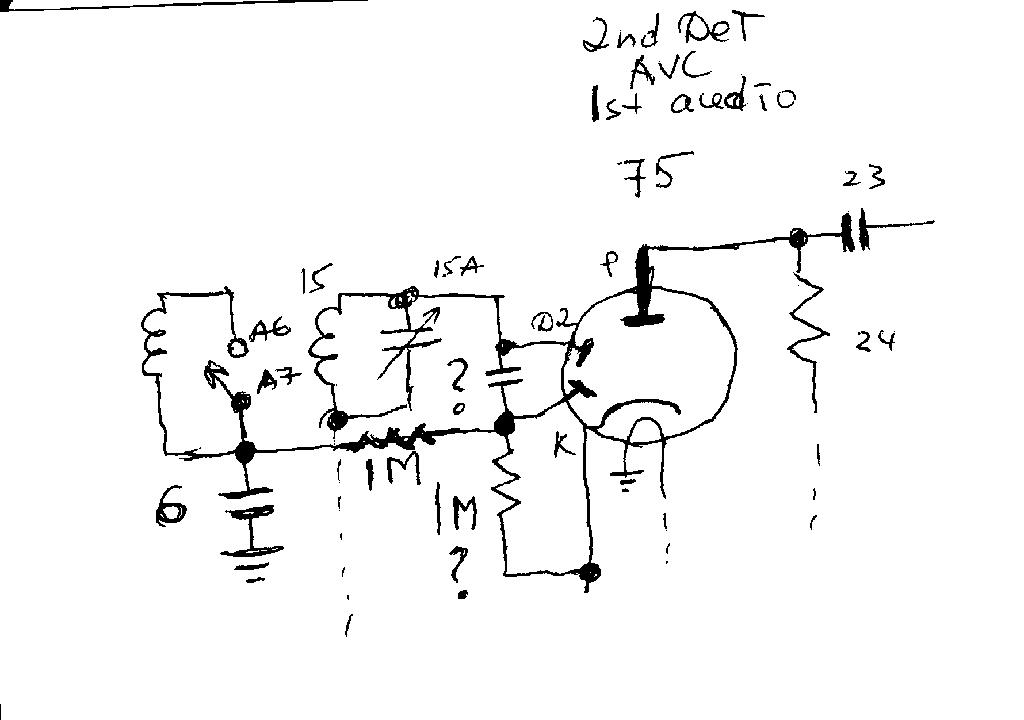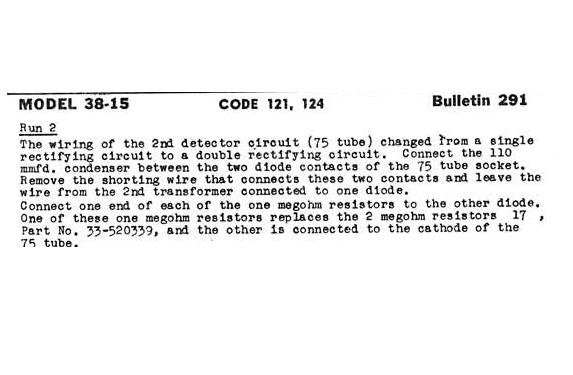Posts: 2,128
Threads: 18
Joined: Oct 2008
City: Merrick, Long Island, NY
Once again repair vs restoration. Of course recap and recarb as well as fuse is in order so that the house does not burn down. The speaker should be the least of your worries.
Back in the day, any which quick and dirty fixes were done to make the radio play once more.
Different story nowadays with antiques.
You'll never get rich(er) doing this stuff, but the little grey cells can be kept active.
Posts: 15,306
Threads: 531
Joined: Oct 2011
City: Jackson, NJ
One thing I hadn't put in any radio is a fuse. Guess I did not want to drill holes in the chassis'. I don't want to put a solder-in fuse as in case it blows (which happens in perfectly normal radios due to transformer-capacitor type inrush) I will have to take the chassis out.
It's a thought though.
Then again, I do not keep my radios plugged in when not in use.
(This post was last modified: 04-07-2013, 09:50 AM by morzh.)
Posts: 15,306
Threads: 531
Joined: Oct 2011
City: Jackson, NJ
One more thing I don't understand about some of the Philcos. It seems every once in a while I see radios where the wires carrying quite a high voltage, like those going to a voice coil (full B+ and rect. output, no resistors in between) go though a hole in the chassis without any grommet or anything to protect them from the cutting edge of that hole. If it ever rubs through, this will be the end of the rectifier section.
Posts: 15,306
Threads: 531
Joined: Oct 2011
City: Jackson, NJ
Well, off to Mouser to buy some caps. Actually I only need one 12uF 450V cap (will use 10uF), but this is the one voltage I do not have the caps of this capacitance for. The rest I have.
Well, maybe I should wait 'till I check all the resistors, so I don't have to double-pay for shipping.
Funny enough, the cap that was supposed to be 12uF was indeed 12uF. It was composed from 2 paralleled caps (that one soldered with a band to the chassis in the pics before), one of which was supposed to be 16uF and another one - 8uF, and both lost enough capacitance so instead of 24uF it is now 12uF.
Of course I am not keeping that one 
Posts: 15,306
Threads: 531
Joined: Oct 2011
City: Jackson, NJ
OK, here's where I need an expert opinion.
I don't seem to have the 2nd Det / 1st Audio hookup as it shown in the schematic for 38-15, both 121 and 124.
Actually both of those are referred to in the same schematic so I figured there is no schematic difference except small things like Grounding one speaker voice coil end in 121.
However, both show that D1 and D2 pins of the 75 tube are together.
In my case only one, namely D2, is connected the way it is shown.
The D1 is disconnected from them and then connected the way it is in this below diagram.

It goes to the cap #6 via what seems to be a 1M resistor and also to the Cathode via another 1M resistor.
Does anyone know if the real hookup like this existed or is it an "improvement" someone did?
(This post was last modified: 04-07-2013, 05:36 PM by morzh.)
Posts: 15,306
Threads: 531
Joined: Oct 2011
City: Jackson, NJ
More news: the replacement speaker I have has the field coil resistance about 500 Ohm. The required resistance is 1,700 Ohm.
As a minimum this means higher B+ voltage on my tubes which coupled with already high compared to the old standard Mains voltage may stress the tubes unnecessarily.
Of course I can insert the resistor. But I am not sure what current this coil was designed to work with, so not sure how well it is going to work being the field coil. Obviously it works somehow, given the fact that this radio worked at some point with this speaker, but how well....
Posts: 13,776
Threads: 580
Joined: Sep 2005
City: Ferdinand
State, Province, Country: Indiana
Morzh
Yes, the change in the 2nd detector circuit is a factory change, and is documented in the Philco Changes in Models PDF I have made available as a free download here:
http://www.philcoradio.com/phorum/showth...hp?tid=215
Go to the link and look for the file changes.zip. Download, unzip, and it is in PDF format so you will need Adobe Reader or other program capable of reading PDF files.
What you are looking for is on page 22 of this PDF file.
--
Ron Ramirez
Ferdinand IN
Posts: 15,306
Threads: 531
Joined: Oct 2011
City: Jackson, NJ
Thanks Ron, where would we be without you....I dare not think.
Posts: 15,306
Threads: 531
Joined: Oct 2011
City: Jackson, NJ
Wow. Exactly what I drew.

(This post was last modified: 04-09-2013, 08:04 PM by morzh.)
Posts: 15,306
Threads: 531
Joined: Oct 2011
City: Jackson, NJ
Ron
Where can I find this Service Bulletin 283 for Model 38-10?
Posts: 13,776
Threads: 580
Joined: Sep 2005
City: Ferdinand
State, Province, Country: Indiana
--
Ron Ramirez
Ferdinand IN
Posts: 15,306
Threads: 531
Joined: Oct 2011
City: Jackson, NJ
Ron
Thing is if you read that change on the page 22 for 38-15 it actually says that this exact change is implemented for 38-10 in this bulletin, so it probably shows the circuit drawing which would be nice.
Hence the 38-10.
Posts: 15,306
Threads: 531
Joined: Oct 2011
City: Jackson, NJ
Today finished recapping and replaced 3 resistors that were outside the acceptable boundaries.
Recapping replaced two electrolytics, 12uF, 10uF, 2uF and 4uF.
Weird thing: Philco employed two different paper caps, each one 0.01uF/400V. Not sure why, but of course both replaced by the same cap. Philco caps, unlike the Zenith ones, open easily and I did not have to drill out the caps - I just pulled them with pliers and they came out. Then I stuffed them with new French-American-Taiwanese mini- Leiden jars and that was it.
Anyway, removed the tubes, checked the transformer. I was afraid a little as the underside wires close to the place where the transformer wires come out were smeared with something tar-like. But tranny works fine and the output seems to be correct.
Checked all the tubes, all test fine except one that is on the weak side but not too bad and it should work.
Put the rectifier tube in, voltage is fine, so I soldered back the tuning cap and put the rest of the tubes in. Soldered back the speaker.
Turned it on, nothing. No voltages. After first jitters (OMG, something shorts) I realize that nothing smokes. So I quickly checked...you guessed it...the input voltage and it was zero. So I found the power cord (not original) has a breakage right where the wires go to the outlet plug.
Removed that, cut a new piece of a cloth-clad wire, soldered it in, plugged it in.
The B+ is OK, though rising very slow (the rectifier tube is testing good).
So I heared the static. Hooked the wire to the antenna input, same thing. The audio works, you can hear the volume regulator making some scratchy noises, static is there but no reception.
I know for a fact all the coils are OK.
So, tomorrow I will try signal generator starting with IF and then back up to the 1-st RF. Will see what it is.
PS. Need a new plug, preferably a Philco one.
Posts: 4,612
Threads: 51
Joined: Sep 2008
City: Sandwick, BC, CA
It sounds pretty much like the usual stuff to deal with in a 1938 radio, hopefully the no reception issue isn't something like the oscillator coil being stuffed.
With regards to a fuse they used to sell plugs with a built in fuse holder for TV sets, I don't know whether similar things are still available anywhere. In any event I think that once a set is rebuilt the chances of something shorting out and causing a fire is reduced considerably.
Regards
Arran
Posts: 15,306
Threads: 531
Joined: Oct 2011
City: Jackson, NJ
When I nought these parts in Mouser I also ordered some panel mount fuseholders and fuses, so I think I install them at the end when all works.
Users browsing this thread: 1 Guest(s)
|



